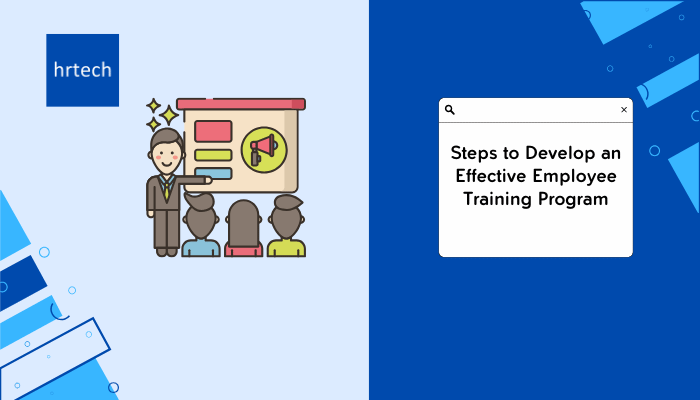Imagine your ideal employee!
A strategic thinker who thrives on change, tackles problems with innovative solutions, and effortlessly embraces new technologies sounds pretty amazing, right?
The world of work moves fast, and the last thing your team needs is a snoozefest disguised as professional development. So, how do you create training programs that are actually engaging and effective? How do you bridge the gap between where your team is now and this future-ready ideal?
The answer lies in a powerful tool- employee training programs!
Did you know that a recent report by the Association for Talent Development (ATD) found that companies that offer comprehensive training programs see a 218% higher return on investment (ROI)?
Investing in your people isn’t just a feel-good initiative, it’s a strategic move that fuels business growth.
Buckle up dear HR professionals, because it’s time to build a workforce that thrives in the ever-changing business landscape!
What is an Employee Training Program?

An employee training program is a structured learning experience designed to develop and enhance the skills and knowledge of your workforce.
These programs can address a wide range of needs, from compliance training to leadership development to software-specific skillsets. Effective training programs are essential for building a high-performing, adaptable, and future-proof team.
Why is a Training Program Important?
Training isn’t just about ticking compliance boxes (although that’s important too!). Here’s why investing in your team’s development is a total win-win:
Identifying Training Needs- Building the Foundation for Success:
Now that we’ve established the importance of training programs, let’s dive into the first crucial step: identifying your team’s specific training needs. Here are some key strategies to pinpoint those needs:
Conducting a skills gap analysis:
This is a systematic process of identifying the difference between the skills your employees currently possess and the skills they need to be successful in their roles. Our Advisory & Consulting services can help you conduct a thorough needs assessment, utilizing proven methodologies to uncover critical skill gaps.
Gathering employee input and evaluating current resources:
Your team is a valuable source of information! Conduct surveys, hold focus groups, or simply have open conversations with your employees to understand their learning needs and challenges. Additionally, evaluate your existing training materials and resources to identify gaps or improvement areas.
Assessing needs through direct observation and feedback:
Pay close attention to day-to-day operations. Are there recurring errors or inefficiencies? Are certain tasks taking longer than expected? Observe your team’s performance and gather feedback from managers to identify potential areas where training could make a significant impact.
Considering the organizational goals and employee performance gaps:
Align your training programs with your overall business objectives. What are your company’s strategic goals for the next year? How can training programs contribute to achieving those goals? Analyze employee performance data to identify.
Transforming HR through Agile Workforce Solutions
Setting Objectives for the Training Program:
Once you’ve identified your team’s training needs, it’s time to chart your course to success!
Defining the Goals of Training Programs with Clear and Measurable Objectives:
Here’s the not-so-secret secret: vague training goals lead to vague results. To avoid wandering aimlessly, define specific and measurable objectives for your program. These objectives should answer the question: “What do we want our trainees to be able to do by the end of the program?”
For example, instead of a generic objective like “improve communication skills,” a more measurable objective could be: “By the end of the training, participants will be able to deliver clear and concise presentations, using storytelling techniques to effectively engage their audience, as measured by a post-training evaluation.”
Aligning Training Objectives with Business Goals:
Remember, training programs shouldn’t exist in a vacuum. Ensure your training objectives are directly aligned with your organization’s broader business goals. Ask yourself:
How will this training program contribute to achieving our strategic objectives?
How will the skills and knowledge gained by trainees translate to improved business performance?
By aligning your training with your business goals, you’re ensuring that your investment in training has a measurable impact on the bottom line.
Utilizing SMART Goals to Ensure Clarity and Achievability:
Here’s where our good friends, SMART goals, come in! SMART is an acronym that stands for:
Specific: Clearly define what you want trainees to achieve.
Measurable: Establish metrics to track progress and assess success.
Attainable: Set realistic and achievable goals that motivate trainees.
Relevant: Ensure the training objectives align with business needs and trainee roles.
Time-bound: Set a clear timeframe for achieving the objectives.
By crafting SMART training objectives, you’ll be setting your program up for success from the get-go.
Choosing the Right Training Methods:

Choosing the right training methods is crucial for keeping your team engaged and maximizing the impact of your program. Here are some key factors to consider:
Evaluating Different Training Types:
Classroom-style: Traditional instructor-led training offers a structured learning environment ideal for introducing core concepts and facilitating discussions.
Workshop-style: These interactive sessions provide hands-on practice and encourage collaboration, making them perfect for developing skills and problem-solving abilities.
Individual vs. Group training: Individualized training offers personalized attention and caters to specific learning needs, while group training fosters teamwork and peer-to-peer learning.
Skills update faster – training keeps teams ahead of the curve.
Bridges knowledge gaps – targeted learning for well-rounded teams.
Boosts confidence & performance – training empowers employees to excel.
Wide variety of programs – caters to every learning style and need.
Measurable results – training delivers a positive impact on the business.
Consideration of Digital Platforms:
eLearning: Flexible and convenient, eLearning modules allow trainees to learn at their own pace. They can be a great option for covering foundational knowledge or refresher courses.
Learning Management Systems (LMS): An LMS acts as a central hub for storing, delivering, and tracking training content. It allows you to create a blended learning experience, combining eLearning modules with other training methods.
Deciding Between In-House and Outsourced Training Options:
In-house training: Leveraging internal expertise can be cost-effective and allows for greater customization. However, it requires dedicated resources and expertise.
Outsourced training: Partnering with a training provider offers access to a wider range of expertise and resources. This can be ideal for specialized training needs or if you lack internal resources.
Understanding Workforce Learning Styles to Select Appropriate Training Methods:
People learn in different ways! Consider incorporating a variety of training methods to cater to different learning styles:
Visual learners: Benefit from graphics, diagrams, and videos.
Auditory learners: Thrive in lectures, discussions, and podcasts.
Kinesthetic learners: Learn best through hands-on activities and simulations.
By understanding your audience and strategically combining different training methods, you’ll create a program that truly resonates with your team.
Developing the Training Content:
This is where you transform knowledge into actionable skills and empower your team to achieve the training objectives. Here’s how to create engaging and impactful content:
Creating Engaging and Informative Content Aligned with Learning Objectives:
Your content should be informative, relevant, and, most importantly, engaging! Focus on clarity, structure, and using real-world examples to connect with your trainees. Ensure the content directly aligns with the learning objectives, ensuring trainees gain the specific skills and knowledge they need.
Involvement of Subject-Matter Experts in Content Development:
Leverage the expertise of your team! Involve subject-matter experts (SMEs) in the content development process. Their deep understanding of the subject matter will ensure the content is accurate, practical, and reflects the realities of the job.
Utilizing Various Forms of Materials and eLearning Tools for Content Creation:
Gone are the days of dry text-heavy training manuals. Today, you have a variety of tools at your disposal:
Case studies and simulations: Provide real-world scenarios for trainees to apply their learnings.
Interactive activities and quizzes: Boost engagement and reinforce knowledge retention.
Videos and multimedia elements: Visually engaging content keeps trainees interested and motivated.
By incorporating diverse materials and utilizing eLearning tools, you can create a dynamic and interactive learning experience that sticks!
Implementing the Training Program:
This phase is all about execution, ensuring a smooth and impactful delivery. Here are some key strategies for implementation:
Preparing Logistics and Setting Clear Expectations for Participants:
Leave no trainee behind! Handle logistics effectively. This includes scheduling, venue arrangements, and ensuring all necessary materials are readily available.
Set the stage for success. Communicate clearly with participants about the training program’s objectives, format, and expectations. This will help them come prepared to actively participate and maximize their learning experience.
Encouraging Active Participation and Incorporating Real-World Examples:
Training isn’t a lecture – it’s a conversation! Here are some ways to keep your trainees hooked:
Incorporate interactive activities, discussions, and role-playing exercises.
Encourage questions and open dialogue.
Bridge the gap between theory and practice by incorporating real-world examples, case studies, and relevant scenarios.
By fostering an engaging environment, you’ll transform passive learners into active participants, significantly boosting knowledge retention.
Don’t just launch and pray! Consider piloting your training program with a smaller group first. This allows you to:
Gather initial feedback from participants.
Identify any logistical glitches or areas where the content needs tweaking.
Refine your delivery style and ensure the program is clear and engaging.
Remember, a pilot program is your chance to fine-tune before the big debut, ensuring a flawless and impactful training experience for everyone.
Evaluating the Training Program:
Training isn’t a one-time event – it’s an ongoing process. Here’s how to evaluate your program’s effectiveness and ensure it continues to deliver value:
Using Feedback Tools and Surveys to Collect Participant Input:
Feedback is gold! Gather participant input through surveys, focus groups, or informal discussions. Ask about their experience, what resonated, and what could be improved. This valuable feedback will guide future program iterations.
Measuring the Training’s Impact on Performance and Productivity:
Did the training move the needle? Track key performance indicators (KPIs) relevant to your training objectives. For example, you might track customer satisfaction scores if the goal was to improve customer service skills. By measuring the impact on performance and productivity, you can clearly demonstrate your training programs’ ROI (return on investment).
Ongoing Assessment to Ensure the Training Program Remains Relevant and Effective:
The world of work is constantly evolving, and so should your training programs! Regularly assess your training content to stay relevant to current industry trends, best practices, and your organization’s needs.
By continuously evaluating and improving your training programs, you’ll ensure they remain a powerful tool for empowering your team and driving long-term success for your organization.
Revising and Improving the Training Program:
You’ve successfully implemented your training program. But wait, the journey doesn’t end here. Just like any successful business strategy, training programs require continuous improvement to remain effective.
Analyzing Feedback and Performance Data to Identify Areas for Improvement:
Remember that goldmine of feedback you collected? Now’s the time to dig in and analyze it! Combine participant feedback with performance data to identify areas where your program shined and areas that need some work.
Look for recurring themes in the feedback. Were there specific topics that resonated with trainees? Were there any aspects of the delivery that could be improved?
Analyze your performance data. Did the training lead to a measurable improvement in the targeted skills or behaviors?
You’ll gain valuable insights to guide future program revisions by analysing qualitative and quantitative data.
Adjusting the Training Content and Methods Based on Evaluation Outcomes:
The training world is all about adaptability! Based on your evaluation findings, refine your training content and methods:
Update content to reflect new industry trends, best practices, or changes within your organization.
Consider incorporating new activities or exploring alternative methods if a particular delivery method wasn’t as engaging as hoped.
Address any knowledge gaps identified by the feedback or performance data.
Continual Improvement Approach to Keep the Training Program Dynamic and Effective:
Training shouldn’t be a static one-time event. Embrace a continual improvement approach. Here are some tips:
Schedule regular reviews of your training programs. This could be quarterly, annually, or whenever there’s a significant shift in your organization’s needs
Encourage ongoing feedback from participants. Informal chats, short surveys, or suggestion boxes can provide valuable insights for ongoing improvement.
Stay updated on the latest trends in training and development. Explore new technologies, methodologies, and resources to keep your programs fresh and engaging.
By continuously revising and improving your training programs, you’ll ensure they remain a powerful tool for empowering your team and driving long-term success for your organization.
Common Challenges and Solutions:
The road to training success isn’t always smooth sailing. Here are some common challenges you might face, along with solutions to help you navigate them:
Addressing Remote and Hybrid Workforce Training Needs:
Gone are the days of everyone gathering in a training room. With remote and hybrid work models becoming increasingly common, you must adapt your training approach.
Solutions: Utilize video conferencing platforms for instructor-led training sessions.
Leverage eLearning modules and Learning Management Systems (LMS) to provide flexible and accessible learning opportunities.
Encourage collaboration and knowledge sharing through online forums and discussion boards.
Engaging Disinterested Learners and Balancing Training with Day-to-Day Work:
Let’s face it, sometimes training can feel like an unwelcome interruption to the workday. Here’s how to keep your trainees motivated:
Solutions: Focus on the “why” behind the training. Help participants understand how the new skills will benefit them in their roles and contribute to their career development.
Make it relevant! Tailor training content to address real-world challenges faced by your team.
Keep it concise and engaging. Break down training into bite-sized modules or microlearning opportunities to avoid overwhelming participants.
Offer training during work hours, if possible, to minimize disruption.
Utilizing Meaningful Analytics to Measure and Track Training Effectiveness:
Training isn’t just about checking a box. You need to demonstrate its impact on your organization. Here’s how to leverage data effectively:
Solutions: Identify the right KPIs (key performance indicators) to track based on your training objectives. For example, you might track customer satisfaction scores if the goal was to improve customer service skills.
Utilize surveys and assessments to measure knowledge retention and skill development after the training.
Track changes in employee performance or productivity metrics relevant to the training objectives.
Conclusion:
Investing in your employees through training is a win-win situation. Effective training programs not only empower your team to achieve their full potential but also contribute significantly to your organization’s overall success.
When your employees feel valued, supported, and equipped with the skills they need to thrive, it fosters a sense of loyalty, innovation, and a commitment to driving the organization forward.
Yeah, the key to successful training programs lies in a structured approach, clear objectives, engaging content, and continuous improvement. With all this info, you can transform your training initiatives from forgettable snooze-fests into powerful tools for building a high-performing, adaptable, and future-proof team.
So, what are you waiting for?
Start crafting your kick-ass training program today, and empower your team to become the unstoppable force that drives your organization’s success!





